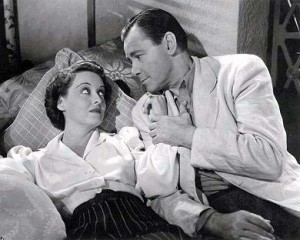The Letter/1940/Warner Bros. Pictures/95 min.
“Strange that a man can live with a woman for 10 years and not know the first thing about her,” says Howard Joyce (James Stephenson) in 1940’s “The Letter,” directed by William Wyler. The woman in question is Leslie Crosbie (Bette Davis), vivacious, charming, self-assured and willful. The man is her husband Bob (Herbert Marshall), sweet, gentle, kind and trusting, and apparently not the sharpest tool in the shed. Or maybe he’s just too busy with work – he runs a rubber plantation in British Malaya. Leslie runs the house and occupies her free time with lace work, tennis parties and gin slings.

Bette Davis and Herbert Marshall play a married couple in "The Letter" from 1940 by director William Wyler.
Howard, a lawyer and friend of the couple, makes his comment in the course of defending Leslie after their tranquil existence suddenly becomes threatened. While Bob is away on business, Leslie receives a late-night visit by an acquaintance, Geoff Hammond, who professes his love for her and tries to force himself on her. So, she shoots him dead; a clear case of self-defense to hear her tell the story. And who doesn’t believe Bette Davis when she’s holding court?
It’s an unpleasant matter, “horrible,” as she says, to be dispensed with as quickly and neatly as the British colonial justice system will allow. And that’s pretty quickly and neatly as these are white, upper-middle-class, upstanding citizens of the empire. It’s smooth sailing, until the appearance of a letter, in Leslie’s handwriting, demanding that Hammond come over the night of the murder and noting that Bob would be away all night.
The letter is in the possession of Hammond’s wife (Gale Sondergaard), a Eurasian native, and she’s willing to let it go for $10,000. But keeping it away from the prosecution and keeping it away from Bob are two different things.
While “The Letter” predates the most prolific period of classic American film noir and its femme fatale is a patrician, married Englishwoman, it is nevertheless a fine example of the form. Just look at the dark, moody, high-contrast lighting, courtesy of cinematographer Tony Gaudio. Nearly every interior scene contains shadowy black bars suggesting confinement. Exterior scenes of lush moonlit landscapes and close-ups of those Bette Davis eyes (the opening scene is particularly memorable) convey the surfacing of the wild, devilish impulses we all struggle to contain.
Then there’s the taut direction by Wyler and sterling acting all round. Wyler, one of Hollywood’s most admired directors, demanded subtlety from Davis, knowing that her strength would resonate on its own. As Leslie Crosbie, she’s an extremely complex femme fatale, equal parts supreme elegance and base evil, one minute winning our sympathy, the next minute making us feel like utter fools for liking her.
Known for being a perfectionist, the German-born Wyler earned the nicknames “90-take Willie” and “Once Again Wyler.” He and Davis had worked together on 1938’s “Jezebel” (for which she won her second Oscar; the first was for “Dangerous” from 1935, directed by Alfred E. Green). Wyler and Davis had an affair that lasted through the production of “Jezebel.” He remained one of her favorite directors. Wyler won three best director Oscars, for 1942’s “Mrs. Miniver, “The Best Years of Our Lives” from 1946 and 1959’s “Ben-Hur.”
Howard Koch wrote the screenplay for “The Letter,” based on a play by Somerset Maugham, who based much of his writing on real-life experiences. (Koch is most famous for rewriting the screenplay of 1942’s “Casablanca” and for writing “Letter from an Unknown Woman” from 1948, among many other works.) In the play, Leslie goes unpunished for her crime (an indictment of colonial justice) but the movie was constricted by the Production Code, which demanded severe consequences for any and all transgressions.
Another of Davis’ most famous roles, Mildred in “Of Human Bondage” (1934, John Cromwell), was also based on a work by Maugham. It was a pivotal performance not only for Davis but for the image of women on the big screen. How so? Said Davis, “She was actually the first bitch leading lady in a film.”
And, for that, FNB will always be grateful. 😉
“The Letter” plays at 1 p.m. Tuesday, July 19, at the Los Angeles County Museum of Art (LACMA), 5905 Wilshire Blvd.
All images copyright of Warner Bros.










From FNB readers